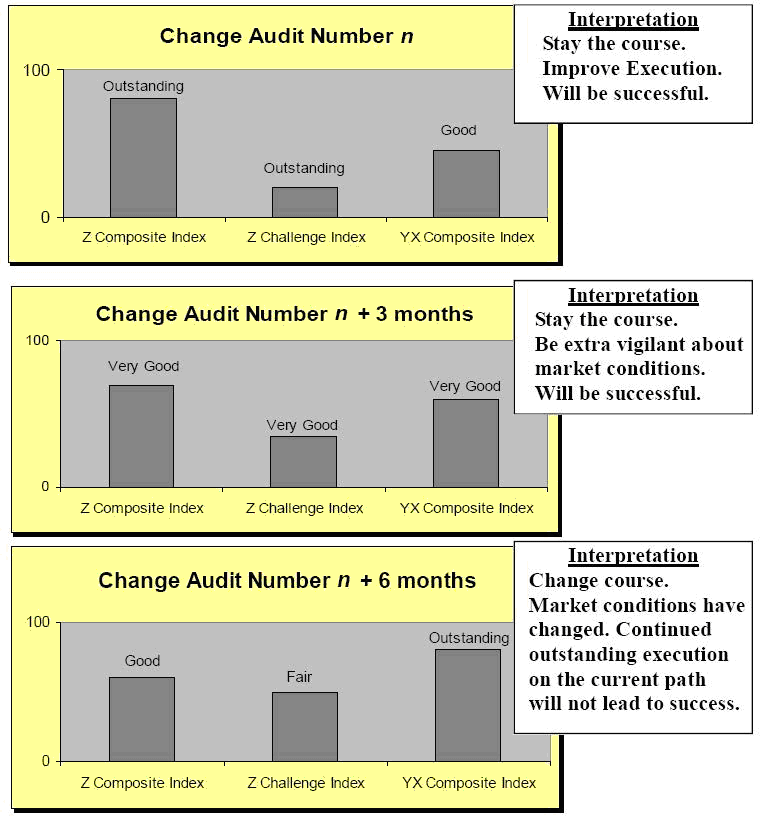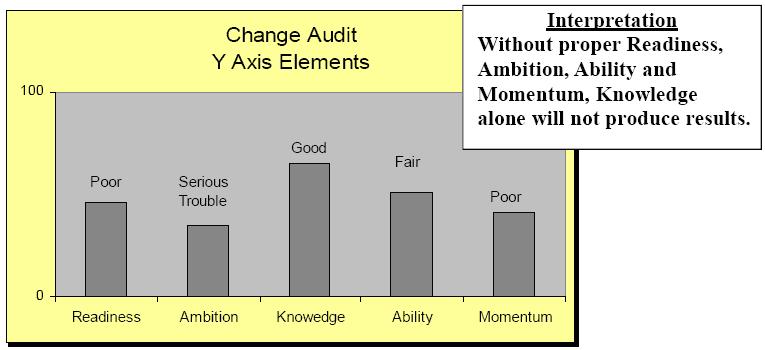|
|
Change Audit is an Early predictor of Success |
Organizations do financial audits. They do safety audits. They
take physical inventory. But they rarely ever think of a change
audit.
Theory ZYX framework offers a new innovative tool: A
structured Change Audit. A Change Audit utilizes the
quintessential Analytical Measurements of Theory ZYX.
The first Change Audit sets up a baseline on all
pertinent aspects that need to change including all elements of
the Z Axis, the Y Axis and the X Axis. The audit can include
both internal and external constituencies.
Subsequent audits can be Mini Audits with specific narrow
focus. It is best to preplan the audits as an integral part of
the change framework. Typical internal constituency includes
employees. Typical external constituencies include customers, suppliers, stockholders, Wall Street, banks and regulators.
The baseline not only helps in better formulations of
plans and better implementation but also allows further
measurements that act as early indicators long before the
results show up in normal business statistics. As
an early predictor of future business results, the
value of a Change Audit is immense. |
|
Analytical Measurements in Action |
|
The best way to illustrate the power of Theory ZYX’s
analytical measurements
is through
examples.
Several examples follow.
|
|
MUST CHANGE THE COURSE |
|
Consider the example of an
organization where a change audit at
interval n revealed that the Z Composite
Index (planning) and the Z Challenge Index were in
the Outstanding category.
The overall YX Composite Index (combination
of the execution and people elements) turned out to
be in the Good category.
The interpretation was that this organization
had an extremely high probability of success.
A mini-change audit at interval n + 3 months
showed that both the Z Composite Index and the Z
Challenge Index had slipped a notch to the Very Good
category.
Further analysis revealed that the slip was
due to market conditions changing in the preceding
three months.
Meanwhile, the management’s focus on
execution
and the
human elements involved was beginning to pay off as
was evident from the YX Composite Index moving up to
the Very Good category.
The interpretation was that the management
needed to stay on course
|
| |
 |
|
Must replace the managers |
|
Senior executives have charged
managers of a division to execute change. The
managers collectively exhibit levels of Conditioning
and Inductivity that fall in the Poor Category.
Fear and Mistrust fall in the Fair Category. Forced
by lack of progress, Senior executives intervene.
The executives are progressive and able to recognize
that the level of Fear and Mistrust are too high.
They guarantee the Managers. job security,
communicate effectively about the plan and start
talking to the Managers about their intentions
regarding the division. A subsequent Mini Change
Audit shows that Fear and Mistrust have improved to
the Good Category
|
| |

 |
| |
| The
Cardinal Sin |
|
The cardinal sin of Change
Management is an attempt to execute change by
providing functional, technical systems knowledge
without adequately preparing the organization for
change and not developing the ability as well as
momentum to generate desired results.
|
| |
 |
| |
|
To learn more about change audits, please read
the book titled THEORY ZYX OF SUCCESSFUL CHANGE
MANAGEMENT A DEFINETIVE GUIDE TO REACH THE NEXT
LEVEL or attend a Change Management Webinar.
|

